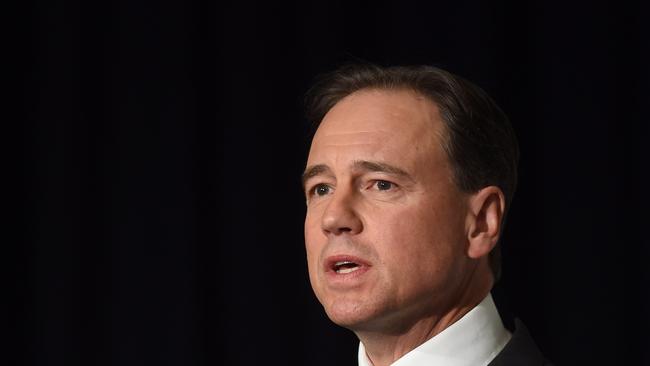Health fund premiums rise $200 a year — how state governments are to blame
HEALTH Minister Greg Hunt has approved a health fund price hike of around $200 a family, three times the inflation rate. Find out what your fund is planning for you.
National
Don't miss out on the headlines from National. Followed categories will be added to My News.
EXCLUSIVE
HEALTH Minister Greg Hunt has approved an average health fund premium rise three times the inflation rate that will add up to $200 a year to the cost of family cover.
But the hike could have been more if not for reforms to cut the price health funds pay for hip and knee replacements and other prostheses.
Mr Hunt will on Friday announce an average 4.8 per cent premium rise, the lowest in 10 years.
“The health insurers have provided the Department of Health with evidence that they have taken the lower cost of prostheses into account in 2017 premiums. This has helped contribute to the lowest increase in 10 years,” he told News Corp.
“I realise cost of living pressures are a major concern for Australian families. Although this is the lowest increase in a decade, I am determined that more can be done to get better value for families.
“As the new Health Minister, I will work with insurers over the next year to find ways insurers can deliver more value for customers without compromising on the quality of cover.,” he said.
“I have already made this clear to the insurance companies and received a commitment that they will work to that end,” he said.
Three of the nation’s four largest health funds have announced premium hikes below the national average.
HCF says its premiums will rise by an average 3.65 per cent, NIB’s premiums will rise by 4.48 per cent and Medibank’s by 4.6 per cent.
BUPA, the health fund with the most members, will increase its premiums by 4.9 per cent, slightly more than the national average.
The price hike will vary depending on which health fund and which policy people hold but the cost of a top hospital and extras policy will rise by around $200 a year to almost $4500 for a family and $100 a year to around $1,250 for singles from April 1.

And News Corp can reveal state government greed is driving the surge in prices.
Public hospitals around the country have introduced policies to encourage patients who have private insurance to claim on their health fund when they attend a public hospital even though they are entitled to free care under Medicare.
Private Healthcare Australia analysis shows in 2014-15 private insurers provided $1 billion to public hospitals and this has been growing at a rate of 12 per cent a year.
Some state governments introduced quotas to force public hospitals to raise their own revenue including by asking privately insured people to pay for treatment that should be free under Medicare.
Research by health consultant Martin Goddard found NSW is the worst offender with hospitals like Sutherland charging 41 per cent of the care it provides to private insurers, at Royal North Shore 34 per cent of patients have the health fund charged.
In Victoria 19 per cent of patients at The Austin Hospital charge their health funds for public care, it’s 18 per cent at Royal Melbourne.
In Queensland, the Royal Brisbane charged the care of 11 per cent of its patients to private health funds, Princess Alexandria 10 per cent and the Mater six per cent.
In South Australia, the Queen Elizabeth Hospital charged the care of 12 per cent of patients to private health funds, 9 per cent at Royal Adelaide Hospital charged 9 per cent and Flinders Medical Centre 6 per cent.
Royal Hobart Hospital in Tasmania charged 23 per cent of its patient care to private health funds while the Launceston Hospital charged 17 per cent of care to private insurers.
It’s an attempt by state governments to boost the money available for public hospitals but it’s hurting health fund members in the hip pocket because it drives up premiums.
And it sometimes leaves fund members facing out of pocket charges from the doctors who treat them.

New analysis shows health fund members who agree to a request by a public hospital to have their health fund pay for their care are driving up health fund premiums by 6 per cent a year.
That is the same as or more than the annual health fund premium rise every year for the last 10 years.
If health fund members rejected the overtures of public hospitals the need for a premium rise this year would have been eliminated.
Health Minister Greg Hunt said he is worried about the cost shifting practice.
“I am concerned that this practice is putting pressure on private health insurance premiums and taking beds away from public patients that need them — and that leads to longer waiting times.
“I will be looking at this issue as a matter of priority because it’s vital that public hospital beds are available for people when they need them,” he said.
Private health insurers say health fund members should be aware they will be driving up their own premiums if they agree to public hospital requests they use their health cover.
“Health fund members need to be aware of their rights if they go to a public hospital ED and they are asked to show their health fund card,” Private Healthcare Australia chief Rachel David said.
“If they are an Australian citizen and Medicare-eligible, they have the right to be treated free of charge because they have already paid through their taxes.
“If they choose to use their health insurance, the hospital must inform them upfront whether there will be extra fees and charges, and needs to appropriately counsel them about options to choose their treating doctor.”

Opposition health spokeswoman Catherine King said when you add up all the premium rises under the Abbott/Turnbull Government families were paying around $900 extra in annual premiums.
“The new Health Minister can’t seriously expect a pat on the back for a 23 per cent increase to private health insurance premiums,” she said.
Ms King said the Government’s massive cuts are forcing public hospitals to beg for money — including from private patients and the Government should fix this problem by “pulling their head out of the sand and properly funding our public hospitals”.
The government has been able to contain this year’s health fund premium rise because it reformed the government pricing system for prostheses like hip and knee replacements.
Health funds will save $86 million a year after the government cut the prices they pay for prostheses like hip and knee replacements but there has been concern this may be creamed off into health fund profits.
News Corp understands the Health Department asked health funds to account for how the cuts to prostheses prices would affect their budgets in the premium rise approval process.
The department analysed each health funds data and analysed it against industry wide data to ensure the prostheses cuts were passed on.
A survey by health insurance comparator finder.com.au has found 6.5 million Australians will reconsider their health insurance cover if prices climb by more than five per cent.
The survey of 2031 people found more than one in three (36%) would switch providers for a better deal — while almost one in four (22%) would abandon their cover altogether if the premium hikes are over five per cent this year.
“Health insurance premiums have risen 48 per cent in just seven years and it’s taking it’s toll on families,” Bessie Hassan, Money Expert at finder.com.au said.
“If you were paying $2000 in 2010, you’d now be paying around $3000.”
To combat the April 1 price rises consumers could pay a year’s premium upfront to avoid anticipated rises, shop for a better deal, or dropping back to just hospital cover, she said.
Originally published as Health fund premiums rise $200 a year — how state governments are to blame


